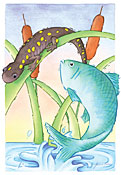

WILDLIFE HABITAT AND NATURAL COMMUNITIES
The Exeter River watershed supports a variety of landscapes including wetlands, forests, ponds, streams, vernal pools, farmland and unique natural communities.These provide habitat for a wide variety of plants and animals. All of the watershed falls within the Gulf of Maine Coastal Plain, a region dominated by hardwood and transitional forests of oak and hickory, hemlock and white pine.
While many areas within the watershed have been fragmented by development, there still exist several areas greater than 1,000 acres of wildlife habitat.These large areas are important to a number of mammal species, such as moose and black bear, that require large home ranges. For many forest dwelling birds large tracts are critical to successful breeding.The river connects the large unfragmented tracts of land in the upper watershed (Chester, Raymond, and Sandown) with the large wetland systems found in Brentwood and Exeter.
The watershed is at the heart of a region supporting several species of concern in New Hampshire.These include spotted and Blanding’s turtles, New England cottontail, and the blue spotted salamander. In addition, a number of bird species reach their northern limits in the coastal plain area of New Hampshire.
The Exeter River is both a cold and warm water fishery that provides habitat for over 17 resident species, including small and large mouth bass, yellow perch, and chain pickerel.The river also serves as a spawning area for alewife and blueback herring. Fish ladders at Pickpocket Dam in Brentwood and Great Dam in Exeter enable anadromous fish (saltwater fish that enter freshwater to spawn and then return to the saltwater) to reach upstream spawning and nursery habitat.

Artwork by Cathy Arakelian and JoAnne Trahan
Website by Cricket Press

Web hosting generously donated by Hurricane Electric